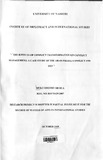| dc.description.abstract | This project investigates the effects of conflict transformation on conflict management, case study of the Arab-Israeli conflict in the period 1990-2003. Five dimensions of conflict transformation, which are; change in structure of a conflict, change in leadership of the actors involved in a conflict, shift from disequilibrium/asymmetry towards equilibrium/symmetry in power of the actors involved in a conflict, breakdown of nationalism/unity among a union of actors with similar war objectives, and the shift towards democracy among the actors involved in a conflict, are discussed in terms ofthe ways in which they affect the management of a conflict.
The Arab-Israeli conflict experienced phenomenal change in its structure by way of great reduction in the number of adversarial actors. Some of the adversarial actors like the USSR collapsed, others like Egypt turned from adversaries to mediators while others like Jordan signed peace agreements with Israel. Reduction in the number of adversarial actors in the conflict has led to reduced scope of the conflict, fewer issues and consequently the management process has been rendered easier.
Actors in the Arab-Israeli conflict have experienced equilibration of power from a situation of great asymmetry to some level of symmetry by way of mutual recognition, round table negotiations and signing of legally binding peace treaties. As opposed to the previous stages of the conflict where some of the actors like Israel and the PLO were not recognized nor could they enter into any negotiations and agreements, equilibration of power by way of recognition, negotiations and signing of peace agreements has rendered management ofthe conflict more fruitful. Actors in the Arab-Israeli conflict have also experienced changes in their leadership.
Changes in leadership of the actors have led to transition from a Ieftist to rightist leadership or vice versa, transition from diplomatic to warmongering leadership or vice versa, transition from conservative to liberal leadership vice versa and so on. Each of these transitions in leadership affects the management process of the conflict either positively or negatively.Unity/nationalism has been weakening among the Arab actors of the Arab-Israeli conflict. Arab states are now prioritizing their own domestic issues as opposed to the communal issue of the land of Palestine. Waning of Arab nationalism has positively affected management process of the conflict by enabling bilateral agreements that comprehensively cover specific issues between two countries. Left on their own, the PA and Syria have to seek peace with Israel via bilateral agreements.
Arab countries in the Middle East are experiencing a shift from authoritarianism towards democracy. This means that leaders have to consult the public before making any decisions concerning wars as opposed to the initial stages of the Arab-Israeli conflict where Arab leaders unilaterally made decisions to go to war. This has eased the management process of the conflict because leaders are forced to take diplomatic route of solving conflicts alongside other peace enhancing traditions enforced by a democratic system.
The study concludes by noting that transformation of conflict affects the ease with which to manage the conflict. Consequently, conflict managers should always monitor transformation of the conflicts they are involved in so as to maximize the opportunities brought by such transformation as well as to decide how to maneuver the difficult situations brought about by transformation of conflicts. | en_US |

